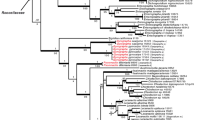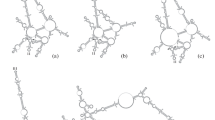Abstract
The results of studying the variability of sequences of the ITS rDNA region for 17 species of the genus Spiraea (Magnoliópsida: Rosaceae) occurring within the Russian part of the ranges and in adjacent territories are presented. The results demonstrate the presence of single-nucleotide substitutions (transitions and transversions) and deletions/insertions, including those specific at the level of subgenera, sections, cycles, and series. The variability in the ITS1 intergenic spacer is higher than in ITS2. The high importance of ITS as a molecular marker in the resolution of phylogenetic relationships in the genus Spiraea is emphasized. Closely related Spiraea species usually differ in ITS sequences, but the polymorphic section Chamaedryon has the greatest difficulties in identifying taxa. Phylogenetic analysis carried out in various ways (ML, MP, and BI) confirms the monophyletic origin of the genus Spiraea and the ancient sections Spiraea and Calospira. A hypothesis is formulated about the paraphyletic nature of the section Chamaedryon, which more evolutionarily young, diverse, and richest in the number of species. It is assumed that the paraphyly of the Chamaedryon section is associated with divergence of traits and subsequent isolation of species along with multiple migrations under the influence of contrasting environmental conditions.


Similar content being viewed by others
REFERENCES
Soltis, D.E. and Soltis, P.S., Choosing an approach and appropriate gene for phylogenetic analysis, in Molecular Systematics of Plant II: DNA Sequencing, Norwell, MA: Kluwer, 1998, pp. 1—42.
Baldwin, B.G., Sanderson, M.J., Porter, J.M., et al., The ITS region of nuclear ribosomal DNA: a valuable source of evidence on angiosperm phylogeny, Ann. Mo. Bot. Gard., 1995, vol. 82, pp. 247—277.
Alvarez, I.A. and Wendel, J.F., Ribosomal ITS sequences and plant phylogenetic inference, Mol. Phylogenet. Evol., 2003, vol. 29, no. 3, pp. 417—434.
Bailey, C.D., Carr, T.G., Harris, S.A., and Hughes, C.E., Characterization of angiosperm nrDNA polymorphism, paralogy, and pseudogenes, Mol. Phylogenet. Evol., 2003, vol. 29, pp. 435—455. https://doi.org/10.1016/J.YMPEV.2003.08.21
Sang, T., Crawford, D.J., and Stuessy, T.F., Chloroplast phylogeny, reticulate evolution, and biogeography of Paeonia (Paeoniaceae), Am. J. Bot., 1997, vol. 84, pp. 1120—1136.
Hershkovitz, M.A., Zimmer, E.A., and Hann, W.J., Ribosomal DNA sequences and angiosperm systematics, Molecular Systematics and Plant Evolution, Hollingsworth, P.M., Bateman, P.M., and Gornall, R.J., Eds., London: Taylor and Francis, 1999, pp. 268—326.
Small, R.L., Cronn, R.C., and Wendel, J.F., Use of nuclear genes for phylogeny reconstruction in plants, Aust. Syst. Bot., 2004, vol. 17, pp. 145—170. https://doi.org/10.1071/SB03015
Derev’ya i kustarniki SSSR (Trees and Shrubs of the USSR), Moscow: Akad. Nauk SSSR, 1954, vol. III, pp. 267—327.
Poyarkova, A.I., Subfamily Spiraeoideae Agardh, in Flora SSSR (Flora of the USSR), Komarov, V.L., Ed., Leningrad: Akad. Nauk SSSR, 1939, vol. 9, pp. 279—318.
Lingdi, L. and Alexander, C., Spiraea, in Flora of China, St. Louis: Missouri Botanical Garden Press, 2003, vol. 9, pp. 47—73.
Yü, T.T. and Kuan, K.C., Taxa nova Rosacearum sinicarum, Acta Phytotaxa, 1963, vol. 8, pp. 202—234.
Businský, R., Transitive inflorescence types in Spiraea (Rosaceae—Spiroideae) undermine the fundamental classification concept of the genus, Phyton, 2015, no. 55, pp. 69—120.
Rehder, A., Manual of Cultivated Trees and Shrubs, Portland: Dioscorides Press, 1940, pp. 322—342.
Polyakova, T.A., Intraspecific variation of species of the genus Spiraea L. (Rosaceae) of the section Chamaedryon Ser. in Siberia and the Russian Far East, in Rasteniya v mussonnom climate: IV (Plants in Monsoon Climat: IV) (Proc. IVth Sci. Conf., Vladivostok, October 10—13, 2006), Goncharova, S.B., Ed., Vladivostok: Botanicheskii Sad-Institut Dal’nevostochnogo Otdeleniya Rossiiskoi Akademii Nauk, 2007, pp. 234—238.
Polyakova, T.A., Morphological trait variation and population structure of Spiraea ussuriensis s.l. (Rosaceae) in Evolyutsionnaya i populyatsionnaya ekologiya (nazad v budushchee) (Evolutionary and Population Ecology (Back to the Future)) (Proc. Conf. Young Scientists, March 30—April 3, 2009), Ekaterinburg: Goshitskii, 2009, pp. 167—173.
Karpova, E.A. and Polyakova, T.A., Seasonal dynamics of the phenolic compound composition in the leaves of Spiraea media var. sericea (Turch) Regel, Khim. Rastit. Syr’ya, 2014, no. 3, pp. 145—149.
Kostikova, V.A. and Polyakova, T.A., Ecological and geographical variation of Spiraea betulifolia Pall. and S. beauverdiana Schneid. according to morphological and biochemical markers, Sib. Ekol. Zh., 2014, no. 3, pp. 413—421.
Kostikova, V.A. and Troshkina, V., Notes on the taxonomy of Spiraea aemiliana and related species (Rosaceae) in Russia, Results and Prospects of Geobotanical Research in Siberia (Proc. Int. Conf.), 2019, p. 4. https://doi.org/10.1051/bioconf/20191600014
Polyakova, T.A. and Muratova, E.N., Karyological study of some species of the genus Spiraea (Rosaceae) of the Far East and Eastern Siberia flora, Rastit. Mir Aziat. Ross., 2015, no. 2(18), pp. 23—26. http://izdatgeo.ru/pdf/rast/2015-2/23.pdf.
Poliakova, T.A. and Shatokhina, A.V., IAPT chromosome data 35/12, Taxon, Marhold, K. et al., Eds., 2021, vol. 70, no. 6, pp. 1402—1411, E35—E36. https://doi.org/10.1002/tax.12638
Kostikova, V.A., Voronkova, M.S., Banaev, E.V., and Poliakova, T.A., The estimation of relative DNA content of the genus Spiraea L., section Calospira C. Koch, Bot. Pac., 2018, no. 7, no. 1, pp. 93—96. https://doi.org/10.17581/bp.2018.07114
Poliakova, T.A. and Shatokhina, A.V., Phylogenetic relationships of the Russian species of the genus Spiraea L. (Rosaceae Juss.) according to morphological and molecular data, in 50 let bez K.I. Meiera (50 Years without K.I. Meier) (Proc. XIII Moscow Int. Conf. on Plant Physiology, February 2—6, 2015, Moscow), Timonin, A.K., Ed., Moscow: MAKS Press, 2015, pp. 263—265.
Potter, D. and Still, S.M., Phylogenetic relationships in tribe Spiraeeae (Rosaceae) inferred from nucleotide sequence data, Pl. Syst. Evol., 2007, no. 266, pp. 105—118.
Huh, M.K., Analysis of the phylogenetic relationships in the genus Spiraea based on the nuclear ribosomal DNA ITS region, J. Life Sci., 2012, vol. 22, no. 3, pp. 285—292.
Khan, G., Zhang, F.Q., Gao, Q.-B., et al., Phylogenetic analyses of Spiraea (Rosaceae) distributed in the Qinghai-Tibetan Plateau and adjacent regions: insights from molecular data, Plant Syst. Evol., 2015. https://doi.org/10.1007/s00606-015-1238-6
Drábková, L.Z., Pospíšková, M., and Businský, R., Phylogeny and infrageneric delimitation in Spiraea (Rosaceae) inferred from AFLP markers and a comparison with morphology, J. Linn. Soc. London, Bot., 2017, vol. 185, pp. 525—541. https://orcid.org/0000-0003-1140-6607
Doyle, J.J. and Doyle, J.L., Isolation of plant DNA from fresh tissue, Focus, 1990, vol. 12, pp. 12—15.
Hall, T.A., BioEdit: a user-friendly biological sequence alignment editor and analysis program for Windows95/98/NT, Nucleic Acids Symp. Ser., 1999, vol. 41, pp. 95—98. https://doi.org/10.1111/jbi.12867
Tamura, K., Stecher, G., and Kumar, S., MEGA 11: molecular evolutionary genetics analysis version 11, Mol. Biol. Evol., 2021, no. 38, pp. 3022—3027. https://doi.org/10.1093/molbev/msab120
Tamura, K. and Nei, M., Estimation of the number of nucleotide substitutions in the control region of mitochondrial DNA in humans and chimpanzees, Mol. Biol. Evol., 1993, no. 10, pp. 512—526.
Nei, M. and Kumar, S., Molecular Evolution and Phylogenetics, New York: Oxford Univ. Press, 2000.
Felsenstein, J., Confidence limits on phylogenies: an approach using the bootstrap, Evolution, 1985, no. 39, pp. 783—791.
Ronquist, F. and Huelsenbeck, J.P., MrBayes 3: Bayesian phylogenetic inference under mixed models, Bioinformatics, 2003, vol. 19, no. 12, pp. 1572—1574. https://doi.org/10.1093/bioinformatics/btg180
Rambaut, A., FigTree, version 1.4.4, 2014. https://www.softpedia.com/get/Science-CAD/FigTree-AR.shtml.
Polyakova, T.A., Shatokhina, A.V., Shirmanov, M.V., and Bondarenko, G.N., Assessment of the taxonomic relationships among the Siberian representatives of the section Chamaedryon Ser. of the genus Spiraea L. (Rosaceae Juss.) based on the analysis of the ITS region nucleotide polymorphism, in Problemy botaniki Yuzhnoi Sibiri i Mongolii (Problems of Botany of Southern Siberia and Mongolia) (Proc. XIV Int. Theor. Pract. Conf., May 25—29, 2015, Barnaul), Barnaul, 2015, pp. 353—358.
Zhang, Z., Fan, L., Yang, J., et al., Alkaloid polymorphism and ITS sequence variation in the Spiraea japonica complex (Rosaceae) in China: traces of the biological effects of the Himalaya—Tibet Plateau uplift, Am. J. Bot., 2006, vol. 93, no. 5, pp. 762—769.
Henrickson, J., Xerospiraea, a generic segregate of Spiraea (Rosaceae) from Mexico, Aliso, 1985, no. 11, pp. 199—211.
Yu, S.X., Gadagkar, S.R., Potter, D., et al., Phylogeny of Spiraea (Rosaceae) based on plastid and nuclear molecular data: implications for morphological character evolution and systematics, Perspect. Plant Ecol., Evol. Syst., 2018, vol. 34, pp. 109—119. https://doi.org/10.1016/j.ppees.2018.08.003
Rodionov, A.V., Kotsinyan, A.R., Gnutikov, A.A., Dobroradova, M.A., and Machs, E.M., The ITS1-5.8S rRNA gene-ITS2 sequence variability during the divergence of sweet-grass species (Glyceria R. Br.), Ekol. Genet., 2011, vol. IX, no. 4, pp. 63—69.
ACKNOWLEDGMENTS
The authors thank E.A. Bondarevich (Chita State Academy of Medicine, Chita) for the assistance in collecting Spiraea samples in Zabaykalsky krai and M.A. Polezhaeva for kindly providing herbarium samples from Sverdlovsk oblast and Chelyabinsk oblast (Institute of Plant and Animal Ecology, Yekaterinburg).
Funding
This study was supported by the Russian Foundation for Basic Research (project no. 15-04-03093) as well as within the framework of the state task of the Ministry of Science and Higher Education of the Russian Federation for Vavilov Institute of General Genetics of the Russian Academy of Sciences (no. 0112-2019-0001).
Author information
Authors and Affiliations
Corresponding author
Ethics declarations
The authors declare that they have no conflicts of interest. This article does not contain any studies involving animals or human participants performed by any of the authors.
Additional information
Translated by M. Novikova
Rights and permissions
About this article
Cite this article
Poliakova, T.A., Shatokhina, A.V. & Politov, D.V. Molecular Phylogeny of Russian Species of the Genus Spiraea (Rosaceae) according to the Nucleotide Variability of the ITS Nuclear rDNA Region. Russ J Genet 58, 1297–1305 (2022). https://doi.org/10.1134/S1022795422110084
Received:
Revised:
Accepted:
Published:
Issue Date:
DOI: https://doi.org/10.1134/S1022795422110084




